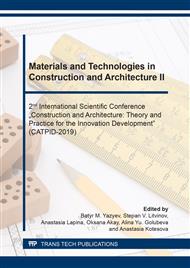[1]
V.M. Kozin, V.L. Zemlyak, Physical basis of the destruction of the ice cover by the resonance method, Komsomolsk-on-Amur, Publishing house of Institute of Engineering and Metallurgy of the Russian Academy of Sciences, Amur State University named after Sholom Aleichem, Amur State Pedagogical University, (2013).
DOI: 10.17223/19988621/61/6
Google Scholar
[2]
R.V. Goldstein, N.M. Osipenko, Some aspects of strength in sea ice mechanics, Physical mesomechanics. 2 (18) (2015) 139-148.
DOI: 10.1134/s102995991502006x
Google Scholar
[3]
E.M. Schulson, Low-speed friction and brittle compressive failure of ice: fundamental processes in ice mechanics, International materials reviews. 8 (60) (2015) 451-478.
DOI: 10.1179/1743280415y.0000000010
Google Scholar
[4]
R. Tsuchiya, Y. Muramoto, N. Shimizu, AC Breakdown Properties of Ice-Alcohol Mixed System, ICSD, Bologna, ITALY, (2013).
DOI: 10.1109/icsd.2013.6619689
Google Scholar
[5]
J. Weiss, V. Dansereau, Linking scales in sea ice mechanics, Philosophical transactions of the royal society a-mathematical physical and engineering sciences. 375 (2015) 20150352.
DOI: 10.1098/rsta.2015.0352
Google Scholar
[6]
H. Kim, J.N. Keune, Compressive strength of ice at impact strain rates, Journal of Materials. 8 (42) (2007) 2802-2806.
DOI: 10.1007/s10853-006-1376-x
Google Scholar
[7]
W.J. Lu, R. Lubbad, S. Loset, Out-of-plane failure of an ice floe: Radial-crack-initiation-controlled fracture, Cold regions science and technology. 119 (2015) 183-203.
DOI: 10.1016/j.coldregions.2015.08.009
Google Scholar
[8]
C.E. Renshaw, E.M. Schulson, S.J.G. Sigward Experimental observation of the onset of fracture percolation in columnar ice, Geophysical research letters. 4 (44) (2017) 1795-1802.
DOI: 10.1002/2016gl071919
Google Scholar
[9]
J.D. Tippmann, H. Kim, J.D. Rhymer, Experimentally validated strain rate dependent material model for spherical ice impact simulation, International journal of impact engineering. 57 (2013) 43-54.
DOI: 10.1016/j.ijimpeng.2013.01.013
Google Scholar
[10]
A.S. Vasilyev, R.I. Bazhenov, T.N. Gorbunova, The Influence of Cross Section Shape on Strengthening of Hollow Core Slabs, Materials Science Forum 931 MSF. 931 (2018) 24-29.
DOI: 10.4028/www.scientific.net/msf.931.24
Google Scholar
[11]
V.L. Zemlyak, V.M. Kozin, A.S. Vasilyev, K.I. Ipatov, Experimental and numerical research of the stressed-deformed state of ice beams reinforced by surface reinforcement, IOP Conference Series: Earth and Environmental Science. 193 (2018) 012031.
DOI: 10.1088/1755-1315/193/1/012031
Google Scholar
[12]
V.L. Zemlyak, V.M. Kozin, A.S. Vasilyev, K.I. Ipatov, The Research of the Stressed Strain State of Ice Beams Reinforced by Surface Reinforcemen, ISOPE, Sapporo, Japan, (2018).
DOI: 10.1088/1755-1315/193/1/012031
Google Scholar
[13]
V.L. Zemlyak, V.M. Kozin, A.S. Vasil'ev, K.I. Ipatov, Experimental and Numerical Investigations of the Influence of Reinforcement on the Load-Carrying Capacity of Ice Crossings, Soil Mechanics and Foundation Engineering. 1 (56) (2019) 37-43. DOI 10.1007/s11204-019-09566-x.
DOI: 10.1007/s11204-019-09566-x
Google Scholar
[14]
K.J. Willam, K.J. Warnke, Constitutive model for the triaxial behavior of concrete, Seminar of concrete structures subjected to triaxial stresses, Bergamo, (1974).
Google Scholar
[15]
Z.P. Bazant, L. Cedolin, Fracture mechanics of reinforced concrete, ASCE J Eng Mech Div. 6 (106) (1980) 1287-1306.
DOI: 10.1061/jmcea3.0002665
Google Scholar


